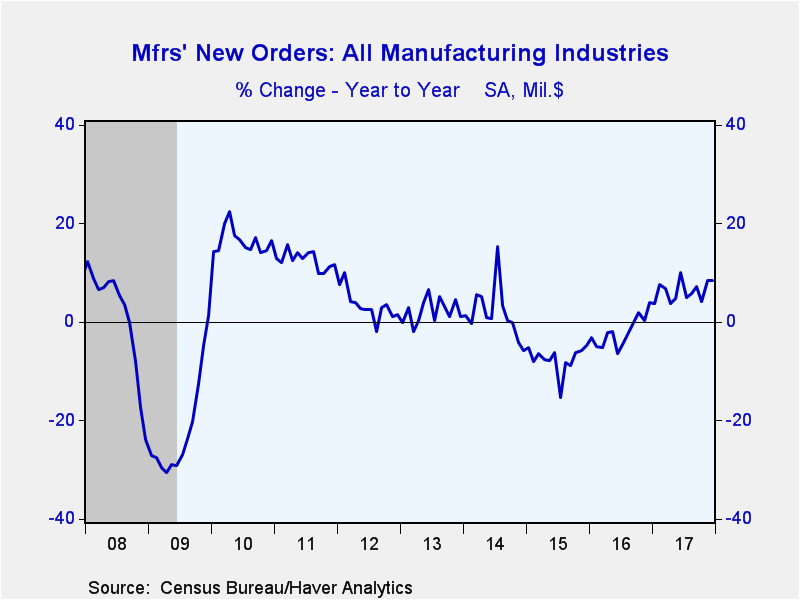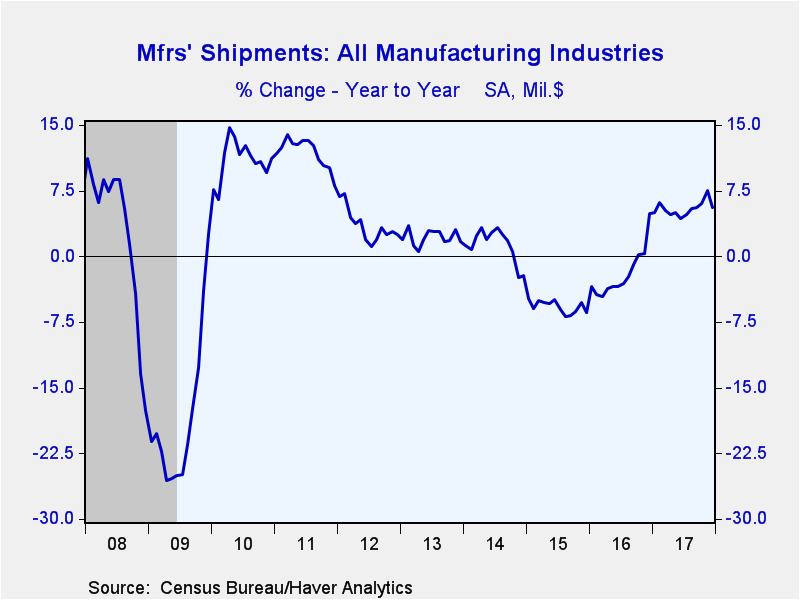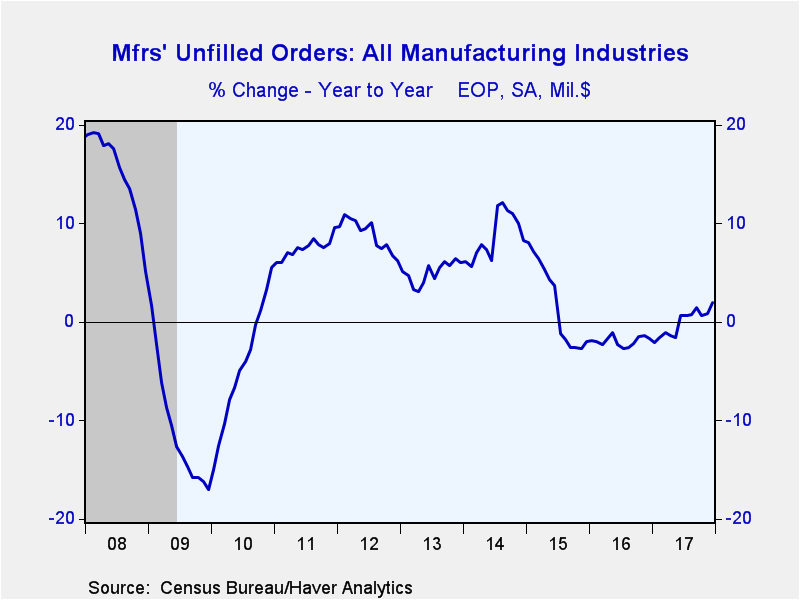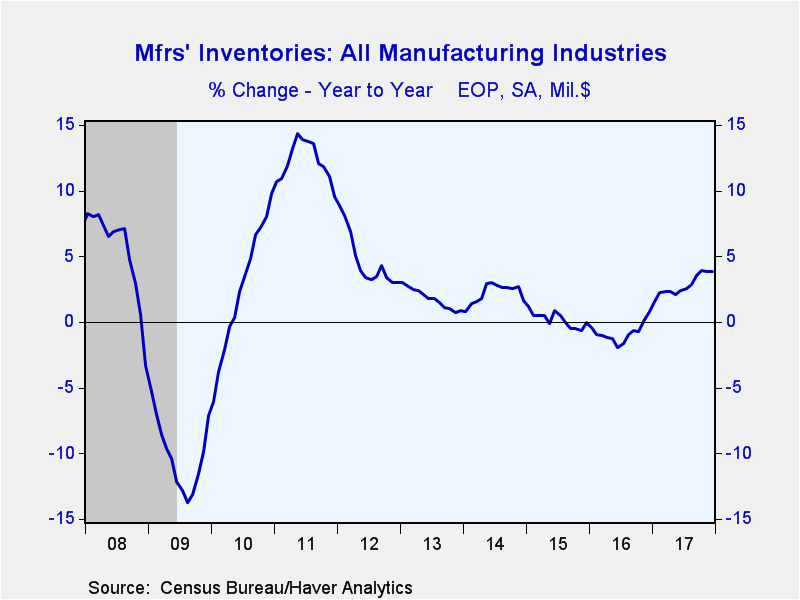 Global| Feb 02 2018
Global| Feb 02 2018U.S. Factory Orders Jump in December
by:Sandy Batten
|in:Economy in Brief
Summary
Manufacturers' orders increased 1.7% m/m (8.4% y/y) in December, the same monthly rise as in November (revised up from the initially reported 1.3% m/m increase). This was the sixth increase in factory orders in the past seven months. [...]
Manufacturers' orders increased 1.7% m/m (8.4% y/y) in December, the same monthly rise as in November (revised up from the initially reported 1.3% m/m increase). This was the sixth increase in factory orders in the past seven months. Durable goods orders jumped up 2.8% m/m (9.6% y/y) vs. 2.9% m/m in the advance report released on January 26 and a 1.7% m/m gain in November. The new information in this report was for nondurable goods. Orders of nondurable goods increased 0.7% m/m (5.5% y/y) in December, a slowdown from a 1.6% m/m jump in November.
The strength in overall factory orders in December was in transportation goods. Those orders were up 7.1% m/m (14.5% y/y) in December following a 4.5% m/m rise in November. As already noted in the advance report for durable goods, the major driving factor was aircraft orders, both defense and nondefense. (Combined aircraft orders were up 24.2% m/m in December on top of a 11.6% m/m gain in November.) Excluding transportation orders, remaining factory orders were up a more modest 0.7% m/m (6.6% y/y) in December following increases in excess of 1% m/m in each of the three preceding months.
Total factory sector shipments rose 0.6% m/m (5.6% y/y) in December 1.2% following an upwardly revised 1.4% m/m increase in November (initially reported as +1.2% m/m). This was the twelfth increase in the past thirteen months. Shipments of durable goods rose 0.5% m/m, down slightly from the 0.6% increase in the advance report. Shipments of nondurable goods increased 0.7% (5.5% y/y) following a 1.6% m/m jump in November. The monthly rise in nondurables shipments was led by apparel (1.6% m/m), beverages and tobacco products (1.6% m/m), and petroleum and coal products (1.4% m/m).
Unfilled orders posted a solid 0.6% m/m (1.9% y/y) rise in December after having edged 0.1% m/m in both October and November. Backlogs of transportation orders rose 0.8% m/m (again led by aircraft) and unfilled orders for primary metals were up 0.9% m/m.
Inventories at the factory level rose 0.5% m/m (4.1% y/y) in December, the same monthly increase as in November. Inventories of durable goods increased 0.3% m/m (4.1% y/y) while inventories of nondurable goods increased 0.7% (4.2% y/y). A 2.4% m/m rise in inventories at petroleum refineries led the rise in nondurables inventories. Inventories of food products rose 0.5% m/m, and apparel inventories jumped 2.1% m/m.
All these factory sector figures are available in Haver's USECON database.
| Factory Sector (% chg)- NAICS Classification | Dec | Nov | Oct | Dec Y/Y | 2017 | 2016 | 2015 |
|---|---|---|---|---|---|---|---|
| New Orders | 1.7 | 1.7 | 0.4 | 8.4 | 6.0 | -1.9 | -7.7 |
| Shipments | 0.6 | 1.4 | 0.8 | 5.6 | 5.2 | -1.8 | -5.8 |
| Unfilled Orders | 0.6 | 0.1 | 0.1 | 1.9 | 1.9 | -1.9 | -2.0 |
| Inventories | 0.5 | 0.5 | 0.3 | 4.1 | 4.1 | 0.7 | 0.0 |
Sandy Batten
AuthorMore in Author Profile »Sandy Batten has more than 30 years of experience analyzing industrial economies and financial markets and a wide range of experience across the financial services sector, government, and academia. Before joining Haver Analytics, Sandy was a Vice President and Senior Economist at Citibank; Senior Credit Market Analyst at CDC Investment Management, Managing Director at Bear Stearns, and Executive Director at JPMorgan. In 2008, Sandy was named the most accurate US forecaster by the National Association for Business Economics. He is a member of the New York Forecasters Club, NABE, and the American Economic Association. Prior to his time in the financial services sector, Sandy was a Research Officer at the Federal Reserve Bank of St. Louis, Senior Staff Economist on the President’s Council of Economic Advisors, Deputy Assistant Secretary for Economic Policy at the US Treasury, and Economist at the International Monetary Fund. Sandy has taught economics at St. Louis University, Denison University, and Muskingun College. He has published numerous peer-reviewed articles in a wide range of academic publications. He has a B.A. in economics from the University of Richmond and a M.A. and Ph.D. in economics from The Ohio State University.










